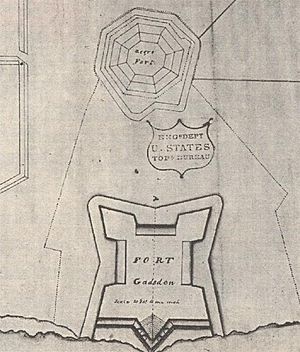The Battle of Negro Fort was an 1816 military engagement in which forces of the United States attacked African-American militia and their native American allies in the frontier of northern Spanish Florida. It was the first major battle of Seminole Wars period and marked the beginning of General Andrew Jackson's Conquest of Florida.[1]
Background[]
In 1814, during the War of 1812, the British Royal Marines established what was known as the Negro Fort on Prospect Bluff along the Spanish side of the Apalachicola River.[2] The garrison initially included around 1,000 Britons[citation needed] and several hundred African-Americans[citation needed] who were recruited as a detached unit of the Corps of Colonial Marines, with a strength of four infantry companies. Shortly after the end of the war in 1815, the British paid off the Colonial Marines, withdrew from the post and left the black population in occupation. Over the next few years the fort became a colony for escaped slaves from Pensacola and Georgia.[1][3]
By 1816 over 800 freedmen and women had settled around the fort, there were also friendly natives in the area. Following the construction of Fort Scott on the Flint River by Colonel Duncan Lamont Clinch of the United States Army, Andrew Jackson decided that to resupply the post, they would have to use the navy to transport goods via the Apalachicola through the sovereign territory of Spain without their permission. During one of these resupply missions, a party of sailors from gunboats 149 and 154 stopped along the river near Negro Fort to fill their canteens with water. While doing so, the garrison of the fort was attacked and all but one of the Americans were killed.[1][3]
In response Andrew Jackson requested permission to attack the fort, they then dispatched gunboats to reduce Negro Fort. Secretary of State John Quincy Adams justified the attack and subsequent seizure of Spanish Florida by Andrew Jackson as national "self-defense," a response to alleged Spanish and British complicity in fomenting the "Indian and Negro War." Adams even produced a letter from a Georgia planter complaining about "brigand Negroes" who made "this neighborhood extremely dangerous to a population like ours."(Fort Negro was a symbol of slave insurrection!) Southern leaders worried that even a small, impoverished island of rebel slaves in the Caribbean or a parcel of Florida land occupied by a few hundred blacks could threaten the institution of slavery.
Battle[]

A plaque at the site of Negro Fort marking the location of the powder magazine.
As the American expedition drew near the fort on July 27, 1816, black militiamen had already been deployed and began skirmishing with the column before regrouping back at their base. At the same time the gunboats under Master Loomis moved upriver to position for a siege bombardment. Negro Fort was occupied by about 330 people during the time of battle. At least 200 were freedmen, armed with ten cannons and dozens of muskets. They were accompanied by thirty or so Seminole and Choctaw warriors under a chief. The remaining were women and children, the families of the black militia.[1][3]
Before beginning an engagement General Gaines first requested a surrender, the leader of the fort was an African named Garson and he refused. Garson told Gaines that he had orders from the British military to hold the post and at the same time raised the Union Jack and a red flag to symbolize that no quarter would be given. Negro Fort was considered heavily defended by the Americans so after forming positions around one side of the post, the navy gunboats were ordered to start the bombardment. After this the defenders opened fire with their cannons but they were not experienced artillerymen and thus were not effective.[1][3]
It was daytime when Master Jairus ordered his gunners to open fire, after only five to nine rounds of hot shot, a cannon ball entered the fort's powder magazine. The ensuing explosion was massive and destroyed the entire post. Almost all of the occupants were killed or wounded and just after the American column and the Creeks charged and captured the surviving defenders. General Gaines later said that the "explosion was awful and the scene horrible beyond description." There apparently were no American casualties.[1][3]
Aftermath[]
Garson was executed by firing squad because of his responsibility for the Watering Hole Massacre and the Choctaw Chief was handed over to the Creeks who killed and scalped him. The survivors were taken prisoner and placed into slavery under the claim that Georgia slave owners had owned the ancestors of the prisoners.[4] Neamathla, a leader of the Seminole at Fowlton, was angered by the death of some of his people at Negro Fort so he issued a warning to General Gaines that if any of his forces crossed the Flint River, they would be attacked and defeated. The threat provoked the general to send 250 men to arrest the chief in November 1817 but a battle arose and it became the official opening engagement of the First Seminole War.[3]
References[]
- ↑ 1.0 1.1 1.2 1.3 1.4 1.5 http://www.exploresouthernhistory.com/fortgadsden3.html
- ↑ J Sean McCormick; University of Florida (April 2007). "A Guide to the General Duncan Lamont Clinch Family Papers". uflib.ufl.edu. http://web.uflib.ufl.edu/spec/pkyonge/clinch.htm.
- ↑ 3.0 3.1 3.2 3.3 3.4 3.5 http://www.africanheritage.com/Angola_Sarazota_NegroFort.asp
- ↑ Department of the Interior - National Park Service. British Fort. http://www.nps.gov/nr/travel/underground/fl1.htm accessed August 8, 2013.
The original article can be found at Battle of Negro Fort and the edit history here.
